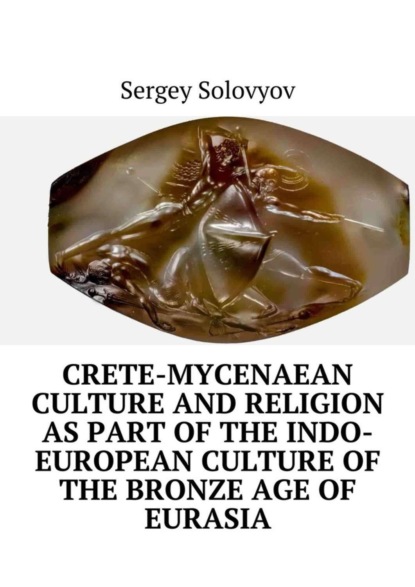
Полная версия:
Crete-Mycenaean culture and religion as part of the Indo-European culture of the Bronze Age of Eurasia
as well as the Athens-Europe holiday in Crete: «a glotoid (ellotid) was a wreath woven from a myrtle wreath with a circumference of 20 cubits and that it was borne out at the festival of Hellotia (Elliotia). In it, they say, they bore the bones of Europe, which [also] was called the Hellottida (Ellotida). Hellotia (Elliotia) was also governed in Corinth.» (Athen XV 678b). But perhaps the Word Illothis-Ellotis is a compound. But the root of Illa Ella is understandable. According to the Hittite sources, there were two areas-Taruisa and Vilusa, but more correctly Ilusa. And Paris-Alexander, apparently was the priest of this deity, and accordingly the favorite of Aphrodite (Helena) -Ella. That is, the kidnapping was thought out by the Greeks much later than the capture of Troy, when they forgot about the identity of Elena and Aphrodite. If you remember the special honor in Aphrodite of the goddess Aphrodite, and that according to Homer Aphrodite was on the side of the Trojans, it turns out that the name Ilion dates back to the real name of Aphrodite, Elle-Ille (one must understand that in the Greek there is no letter «E»). In the retelling of the Trojan War, there is a hint that the main thing for the capture of Troy was the return to the Greeks of palladium, that is, the sacred image of Athena. And then again, the connection with the myth of Gelle (Ella) and Fricke is slipping. And it seems that the first Hellas (Hellas) was a Trojan. After the Trojan War, Neoptolemus took Andromache and took part of the Trojans to Thessaly. The first area, called Hellas, was in Northern Greece. Now, more in detail about Persephone and Perseus. So, the meaning of the word «Persephone» is «Perseus + phonos, that is, the sound or voice.» That is the voice of the dead.This is not even a name, but an epithet, like Tritiginea for Athena. Perseus, his birth is also associated with the cult of the dead He was born in a tomb from a deceased mother, or taken for a deceased mother, Danai.The exact translation of the word
«Perseus» is not yet obtained, but the meaning, as in the analogy with Persephone is clear, and is connected with the dead. The cult of Persephone is associated with Eleusis, with the famous Eleusinian mysteries. And then the fun begins. The root of «Ela-Eli» is the name of the goddess Aphrodite. That is, the city is named after the goddess Ella-Aphrodite. And Persephone is only one of her epithets. The connection of Aphrodite with the cult of resurrection is clearly visible in the photos of Acroteri. But the legends about Persephone to the goddess of the dead from the Greeks did not survive in the epics, because they were part of the Eleusinian mysteries and were secret. With Elesia, the name of the Champs Elysees, a place in the next world, where the chosen ones fall, is also connected, that is, these fields belong to Elisia, Ἠλύσιον πεδίον-the Champs Elysees, the name of Lysias the next, and Alexius the resurrected. Therefore, here you can reconstruct part of the fairy tales of Mary-Morevna and Mary-Iskusnitsa, that is, the Mara-goddess of death. But the name of the Iranians-Parsa or Persians comes to the aid. The self-name of Iran in ancient times was «Arya-nim», the country of Aryans. That is, Persian-Parsa refers to religion, or rather to the rite of burial. The photo below shows the birth of a goddess from the waters of the sea, from the flower, and depicts the symbol of the revival of the palmetta. Below is also a helmet made of gold with an acanthus-symbol of rebirth.
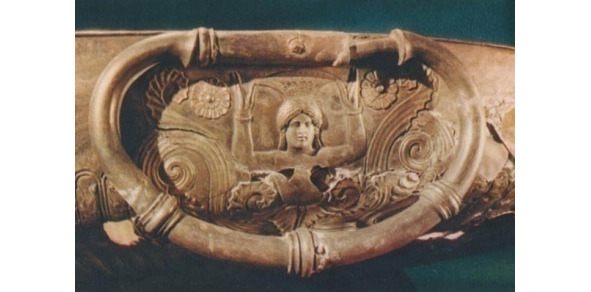
Pic. 11 of a born goddess
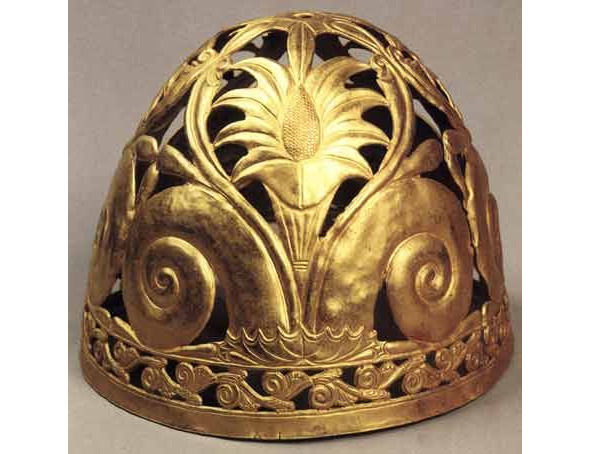
pic.12 Gold Scythian helmet, or rather the crown. Hermitage, St. Petersburg
In the photo below, it seems, but in the center there is either an inflorescence, a ready-to-blossom, or an egg, as a symbol of a new life… So this obviously symbolizes the hope for the resurrection of the Goddess worshiper.

pic 13. Palmetto on acroteria (tombstone)
It is possible to reconstruct the meaning of the Eleusinian Mysteries as the greatest mystery of Ancient Greece, the Hellas-the True Name of the Mother Goddess-Ella-Elena, and the proof that both Hera, and Athena, and Persephone, and Artemis, (known numerous images of Artemis-Orphia, and from her the head grows a flower) and Aphrodite is only her incarnation. as she manifests herself in the world of people. And, the most important, can be considered proven. What and the self-name is Hellenes. and the name of the Hellenic country, this is the manifestation of the Hellenic belief that they are created by the goddess Ella, and believe in their resurrection after death, and are under her protection. The name is Helen in Greek – from ancient Greeks. ἐλένη (helen) – «torch, torch». And everything in the world is the product of her mind (photo above). the last photo-Mycenaean work of the 16th century BC, the first-bronze statuette from the Pushkin Museum of Fine Arts. Pushkin). In the exposition of the Pushkin Museum there is a bronze statuette of Aphrodite with Eroth. And now, from above, behind the head, is the same symbol of the creation of the Goddess of all things with his mind. A photograph from the Athenian Museum (a hairpin made of gold in the form of a goddess) -Mikena work of the 16th century BC. similar to Aphrodite with Eros from the collection of the Pushkin Museum. Pushkin. To the right of the plate from Sparta. the classic time, the image of Artemis-Orifii. In the photo below the image of the sprouting shoots of the goddess, the Goddess-Mother, Who created Everything from Self, this is what these images are dedicated to. That is, as sprouting from itself to all living things, the goddess is the creator of everything. And also images with animals to which she also gave life.
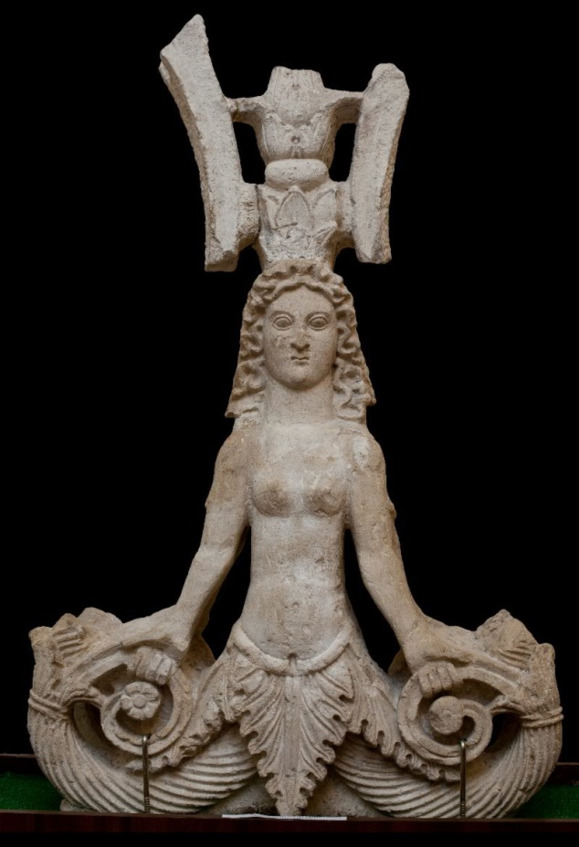
pic.14 Birth of the Goddess
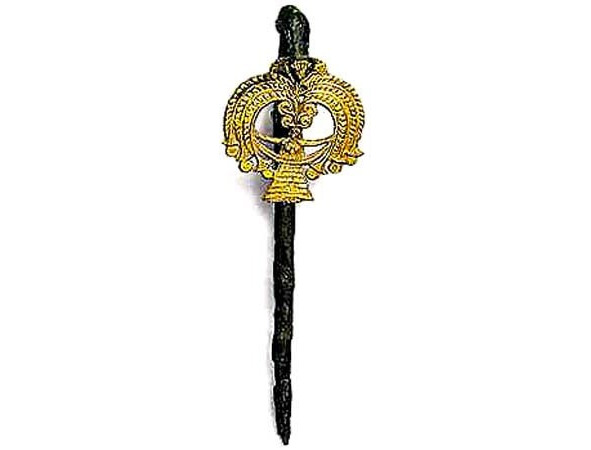
pic.15 Hairpin with the image of Elisia
Many of the capitals of the Greek columns in the temples depict the symbol of the goddess Ella-Helena, a blossoming flower, Acanthus or palmetta, as a symbol of the rebirth from death. The custom of giving flowers, bouquets, is obviously connected with this cult. And here, one of the hints of the ancient philosophers becomes clear: «Everything in the world is a product of love.» And it turns out that the Christian priests were right, identifying Hellenism and paganism. Ellinism is not a nationality, but a system of very stable religious and cultural ideas, the most important of which is the belief in the Mother Goddess, and the hope of resurrection after death.
Dating of Schliemann’s Treasure
A number of Schliemann’s finds, called the «Priam’s Treasure», were found on the site of the site of the site, recognized as the ruins of Troy. Artifacts were found on the foundations of the main building of the Troy Acropolis from 1873. to 1882. with interruptions. These are treasures with ordinal numbers A to R. As it is already believed, the treasure has nothing to do with the king of Troy Priam. It dates from 2400—2300 years. BC., that is, existed a thousand years before Priam. Let’s try to clarify this date. William Taylor, in his book The Mycenaean and Mycenaeans, writes about the origin of the Hellenes (or rather the Achaeans), that materials and a large archaeological work inspired researchers to answer the question of the origin and differences of those people who created Mycenaean monuments and culture.
Is it correct to say that the Mycenaean century marked the beginning of Hellenic culture? In Greece, not once and not two fell different peoples, including in historical time. Finds of archaeologists show that up to the classical period the continuous development of civilization continued. In the period from 1900—1800 BC. across the whole of Greece began to spread new ceramics with characteristic features, known as gray «minyan» products. The name was offered by Schliemann, who first came across it during excavations in Orchomen. He named it in honor of the Mynyan tribe, which, according to legend, is associated with this city. The name was unsuccessful, because in fact this tribe is not associated with the origin of ceramics. Minyan ceramics are easy to distinguish from all other gray products due to their excellent quality and very specific finishing technique. Most likely, according to Taylor, she was brought to Greece by representatives of one of the nomadic tribes. In the form of vases, a resemblance to metal products is seen in Taylor’s opinion. The ceramic products, similar to the gray minyan ceramics, were found by archaeologists throughout North-West Turkey, they have distinctly expressed signs of TroyVI ceramics, which indicates a homogeneous population of this region of Asia Minor at the beginning of the second millennium BC and the base the sixth settlement around the XIX century. BC. Practically simultaneous appearance of similar ceramics in two separate but not very distant territories suggests that both Troy and Greece were invaded by the same invaders. It is commonly believed that they brought to Greece and one of the forms of the Greek language. The bearers of this culture came from the east, passing through the northern Anatolian plateau in Troy. Indeed, the Mycenaean ceramics are in some ways similar to gray products from the northeast of Iran. The invaders brought with them new types of weapons, primarily cavalry and chariots, which played a decisive role in keeping the occupied territories. For the first time, the horses’ bones were found in the TroyVI along with minyan products, possibly a wave of invaders penetrating Greece, brought with them horses. This theory contradicts the fact that in later times the transportation of horses by sea through the straits that separate Europe and Asia was a dangerous, if not a lethal, operation. For about two centuries, the invaders strengthened their positions, absorbed and integrated the existing culture, increasing their own well-being and strengthening their power, facilitated by coastal trade and piracy. At the beginning of the XVI century. There is an increasing influence of Crete on their culture and, it can be said, the phenomenon known as the Age of Mycenae begins. States of the Mycenaean type, similar to those described in the Iliad, began to form in Athens (although not very significant), and also in Attica. The strongest power Miken showed up in the Peloponnese, where Pylos ruled Messenia, as well as in a group of fortresses in Argolid, dependent on Mycenae. Lakonia lying between these two territories has not been explored, and its Mykene capital has not yet been discovered. So, Taylor relies on the specific Mingyang ceramics in the dating, and speaks of the proximity of the Trojan culture and the Greek (Achaean). Some, the most important elements of jewelry, namely the lobed temporal rings of women’s rings, allow us to put forward a hypothesis about migration of nomadic tribes from the Ural steppes to Asia Minor, Iran and Greece. Now we turn to the dating of the Treasure of Schliemann, and what the researchers base on dating. The treasure itself was in a silver two-handed vessel. It consisted of more than 10,000 items. Most of all there were gold beads – about 1000. And the beads were very diverse in form – and a small beads, and thin tubes, and beads with flattened blades. When was done the reconstruction of the breast pectoral, consisting of these beads, turned out twenty luxurious threads of a necklace, to the bottom of which 47 gold rods were suspended, and in
center was located one very special – with thin slicing. Also unique are the rings, called the temporal lobular rings-the number of parts from two to six. The top rings were made from the materials of the finds, from gold and silver. It is interesting to show the bipartite ring from the Treasure of the Climber of Schliemann Catalog inventory number Аар132, Бз50, П92 F6014 and Аар 133 Бз49, P91 A 6015..
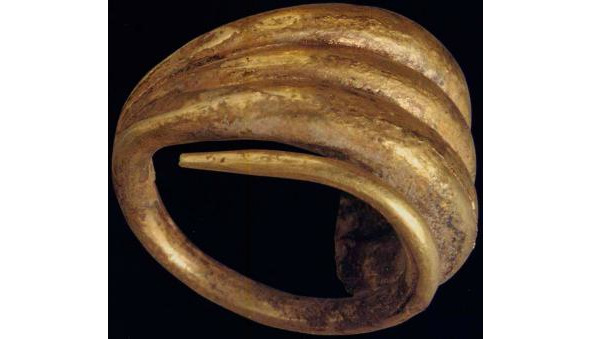
pic.16 Lobular rings from the Treasure of Priam, Pushkin Museum, Moscow
A bipartite gold ring from the Collection of the GIM (Historical Museum). Photo dsc00946. These findings only confirm Taylor’s theory of the advancement of pastoral tribes to Asia Minor and Greece. The find is dated to the beginning of the second millennium BC. Now let’s turn to the finds of Abashevskaya and Andronovskaya kultury. Oni developed in the forest-steppe zone of Eastern Europe, whose monuments are found from the left bank of the Dnieper in the west to the Tobol River. It dates from the beginning of the middle of 2tys. BC The same distinctive feature can be seen in the decoration of the vessels of the pattern «meander», as well as dicotyledonous golden rings. In the Urals, in the peat bogs, wooden scoops with a figure of a swan are found. similar to the crystal cup from Mycenae of the same time (photo below). On materials of archaeological excavations, as well as on the images of chariots on vessels, it is evident that people of this culture bred horses and used chariots.
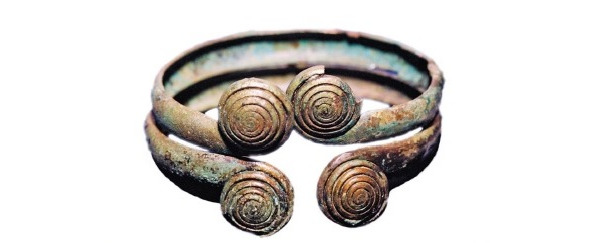
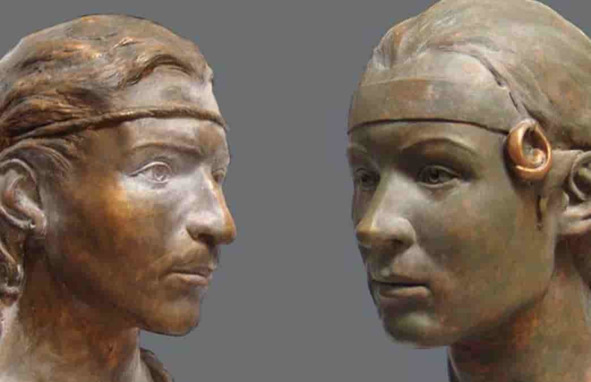
pic.17 Lobule ring and open bracelet. Orenburzhye, SHM, Moscow Reconstruction of the image of the inhabitants of Arkaim. The temporal lobular rings on the woman on the right.
The finds in Arkaim also of bipartite temporal rings of gold indicate that this culture was quite highly developed, people were working on bronze, gold, and wood. It was quite a cultural and technological society for that time. And at least they built fortified points.
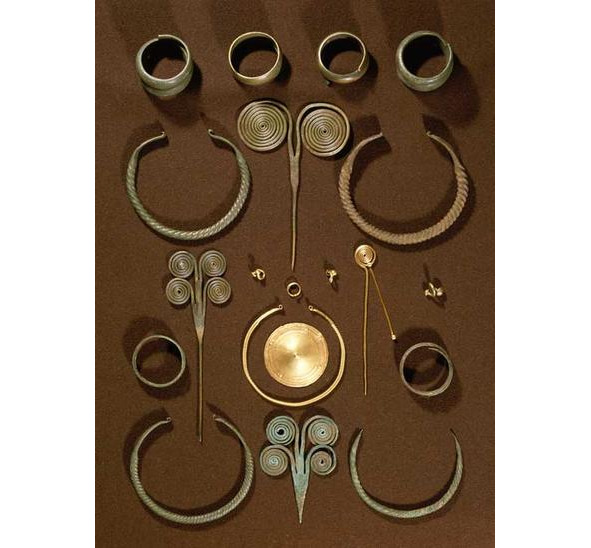
pic.18 Lobate ring from Denmark Gammelgard. From the top, the first four. 13th century BC National Museum, Copenhagen.
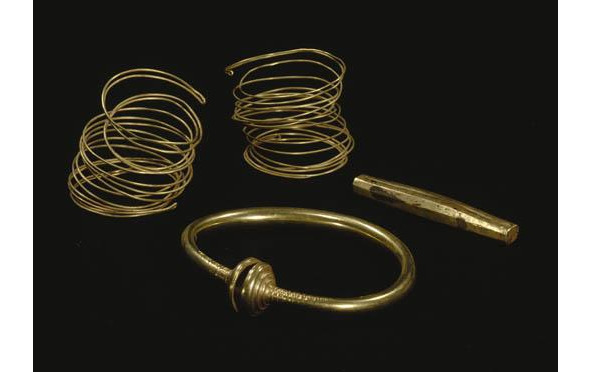
pic.19 Sacrificial contribution: includes two spiral rings on the hand, an open ring resembling rings of the same type of Abashev culture and Sintashta culture and a gold bar from Frederiksborg County.
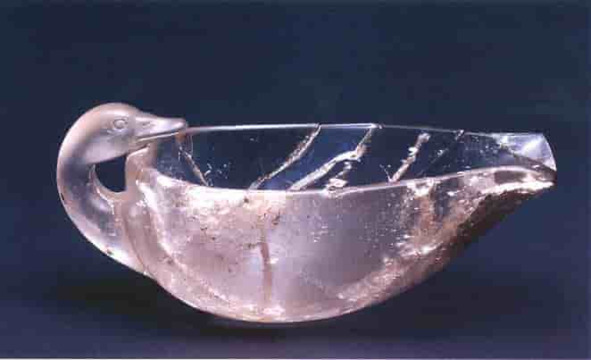
crystal cup from Mycenae,
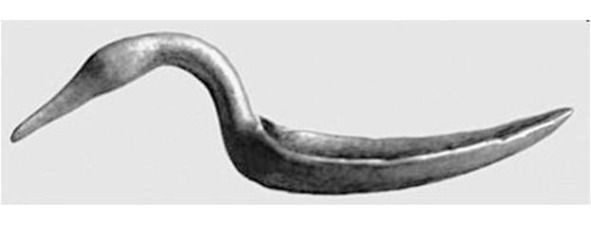
pic.20 wooden scoop, Ural. mid-15th century BC
The quality of the processing of products is simply amazing.. A similar lobed ring was found in Denmark in the Borgbjerg Bank in West Zealand. is dated to the lobate ring of the 11th century BC., the same lobed rings are found in Vejle, and date back to the 11th century BC. Similar lobed triple rings were in the cloak of Priam, although rings from Asia Minor are incomparably more rough work. The ring is decorated with beautiful ornaments, and according to the processing technique without any praise, it’s just a magnificent work. Also with the lobed ring in Denmark were found beautiful golden bowls with handles in the form of horses and bowls resemble a bucket of wood found in the Urals. Now you can go to the dating questions. The temporal lobular ring from Russia dates back to the middle of 2 thousand В.С. (Orenburg Region, Abashevskaya Culture) Treasure’s Schliemann Treasure dates back to 2200—2400.В. С. Based on the materials of the cross finds in Troy and Russian Orenburzhye, the date shifts to the end-middle of 2000 BC, (also Abashevskaya Culture) consequently to the epoch of Troy 6, and not to Troy 2. Why did this happen? Because of the confusion in the dating in the foundations of houses. The example of Rome can confuse any archaeologist-many houses of the 18th and 19th century are built on the foundations of houses 2—4 AD.
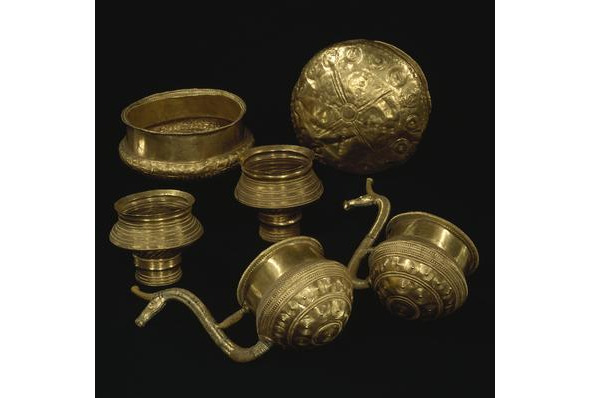
pic.21 Gold bowls from Denmark, late bronze age. a handle in the form of a horse’s head. The type of vessel is close to the findings in the Urals and the crystal cup from Mycenae. Remind small buckets from Russia, podezhivali on a large vessel by the handle.
So, the similarity of the cultures of the pastoral tribes of the forest-steppe zone of Eurasia and Troy is traced not only in ceramics, but also in ornaments (temple rings made of gold, gold necklaces, and similarity of buckets with headband in the form of a swan), which again confirms the conclusions Taylor on migration from the Eurasian steppes to Asia Minor, Northern Iran and Greece.
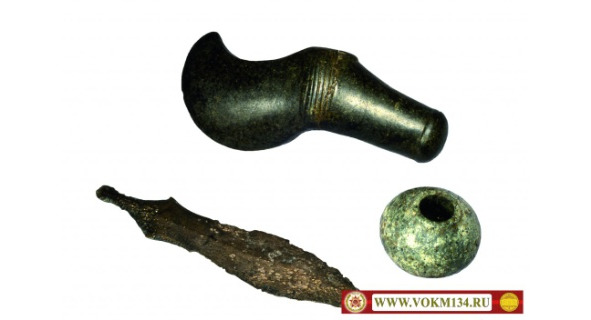
pic.21 A stone ax made of jade, found in the Volgograd region. The shape of the ax resembles the shape of the ax of the Borodino Treasure, the first from above. The Bronze Age. around the 15th century BC Volgograd Local History Museum.
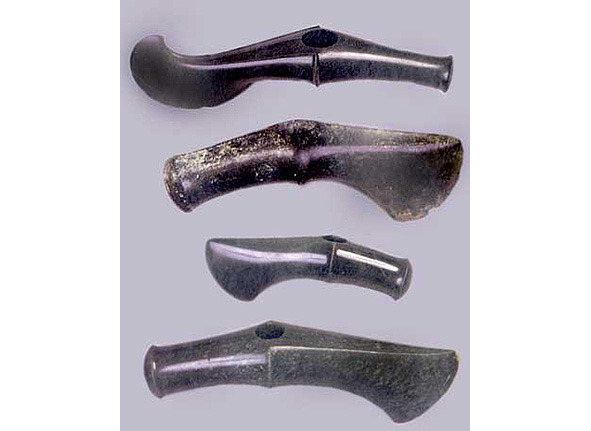
stone axes from the Borodino Treasure (XIV century. SHM, Moscow)
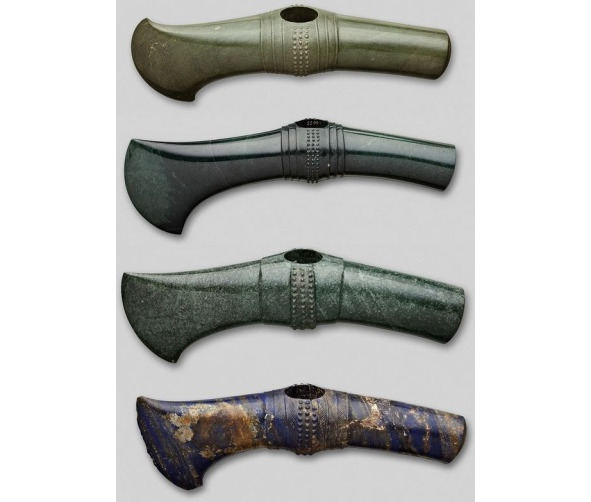
pic.22 Axes from Troy, according to research materials in the Pushkin Museum, were covered with gold foil. and Klad Priam (right) the probable date of the XIV – XIII centuries. BC. Pushkin Museum of Fine Arts, Moscow
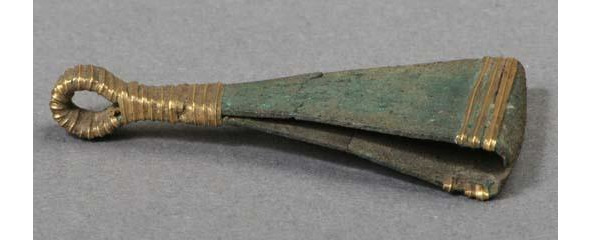
pic.23 Bronze tweezers, decorated with gold foil. Denmark, the late Bronze Age.
Nikulina N.M. in his work «Ritual axes-hammers of the Trojan treasure»: «Trojan hammers-axes are, in their image and content, especially close to the circle of Aegean ritual objects, although they also have the Asiatic parallels (they will be discussed below) Cretan and Mycenaean Labrysides of the 16th-15th centuries BC and stone ritual hammers-axes from the treasure of L, made of nephrite, jade and rock, close to lapis lazuli, made in a very complex technique that imitates metal products (bronze, gilded bronze or gold), in our opinion, are quite comparable with each other.They create a very convincing visual series that makes you think about a real chronological definition of the famous Trojan monuments.The presence next to the stone hammers-axes in the same treasure L several pommels of rock crystal, completely similar to the crystal tops of daggers from Mycenaean royal tombs of circle A, only increases doubts about the dating of the archaeological complex under consideration, revealing one more binding with the circle of monuments of the Aegean artistic culture. «The presence in the complex of the treasure L of the caked metal and the very forms of small objects that have appeared in this conglomerate, in our view, do not in the least contradict the later dating of the entire L treasure as a whole. Carnations and other objects of a similar shape exist also in the 2nd millennium BC) Half of the iron top (iron slag) found in the same complex of the treasure of L is, apparently, only an additional confirmation of the correctness of our definition. Reference to A. Getz, who believed that beads, sintered metal and iron slag could not be associated with this treasure, is not too convincing, especially since even with regard to the ritual hammer axes, Goetze spoke rather vaguely. In our opinion, all these items still treated this treasure, and there are no contradictions here. As a result, proceeding from the technological analysis of the Trojan monuments examined, the late dating of the treasure L, – II millennium BC, with even greater distinctiveness, looms. (1700—1500 BC). «Karl Blegen, in his book» Troy and the Trojans», speaks of the ritual stone axes from Troy: «Most of all it looks like a weapon that was in use in Bessarabia» (meaning the famous Borodino treasure). The Borodino Treasure is found approximately in the middle of the 2nd millennium BC That roughly coincides with the monuments of the Abashev culture as well, that is, Nikulina NM also relates the time, at least, of making the treasure to the time of Troy 6. And then, as it is not sad for the skeptics, Schliemann still found the Treasure of King Priam. (At least, it can be relied to the era of the Trojan War).
The tactics of the Achaean chariots in battle
One of the keys to understanding the process of the genesis of the chariot today is the radiocarbon date for the construction of 32 burials of the Great Ipatovsky Barrow – the XXIII century BC. as the most probable. This fact allows us to speak about the inclusion of a circle of Manych catacomb monuments in the area of chariot formation. The Sintashta interval of dating dates back to 1970—1770 (2030—1750). BC. To the same period belongs a vessel from the State Historical Museum (hereinafter – GIM) pic.24. The vessel shows a schematic image of the chariot. In the same way, these tribes used the meander in the cult objects, and there are numerous finds of lobular temporal rings of gold attributed to the same period, as well as boat-shaped wooden cups found in swamps, with a head in the form of a duck swan. Such a find, only a cup of crystal, found in Mycenae, dates back to the 16th century. BC. Lobular temporal rings are found in Troy, and, therefore, can be dated from the same 17th-18th century BC. or earlier. The lobed temporal rings in pic.17 from the collection of the GIM belong to the beginning of the 2nd millennium BC. But cultural unity is obvious.
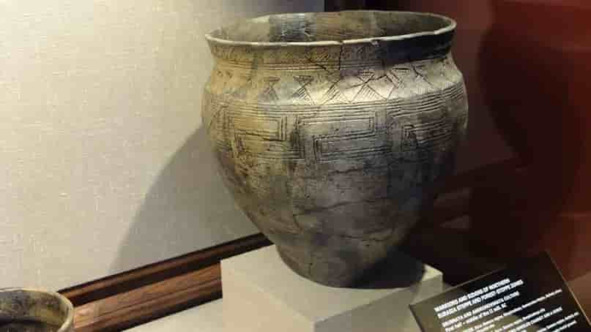
pic. 24 Vessel from SHM, Moscow. Abashevskaya culture.
Most likely, according to Taylor, this culture was brought to Greece by representatives of one of the nomadic tribes from the steppes of Eurasia. According to Taylor in the form of vases, a resemblance to metal products can be seen. Ceramic products, similar to the gray minyan pottery, were found by archaeologists throughout North-West Turkey, they have distinct signs of Troy VI ceramics, which indicates a homogeneous population of this region of Asia Minor in the early 2nd millennium BC. and the founding of the sixth settlement around the 19th century. BC. It can be argued that representatives of this culture brought to Greece, Egypt, and the Far East the art of making and using chariots. Practically simultaneous appearance of similar ceramics in two separate but not very distant territories suggests that both Troy and Greece were invaded by the same invaders. It is commonly believed that they brought to Greece and one of the forms of the Greek language. The bearers of this culture came from the east, passing through the northern Anatolian plateau in Troy. Indeed, the Mycenaean ceramics are in some ways similar to gray products from the northeast of Iran. The invaders brought with them new types of weapons, primarily cavalry and chariots, which played a decisive role in keeping the occupied territories. For the first time, the horses’ bones were found in the TroyVI along with minyan products, possibly a wave of invaders penetrating Greece, brought with them horses. Most likely, according to Taylor, this culture was brought to Greece by representatives of one of the nomadic tribes from the steppes of Eurasia. According to Taylor in the form of vases, a resemblance to metal products can be seen. Ceramic products, similar to the gray minyan pottery, were found by archaeologists throughout North-West Turkey, they have distinct signs of Troy VI ceramics, which indicates a homogeneous population of this region of Asia Minor in the early 2nd millennium BC. and the founding of the sixth settlement around the 19th century. BC. It can be argued that representatives of this culture brought to Greece, Egypt, and the Far East the art of making and using chariots. Practically simultaneous appearance of similar ceramics in two separate but not very distant territories suggests that both Troy and Greece were invaded by the same invaders. It is commonly believed that they brought to Greece and one of the forms of the Greek language. The bearers of this culture came from the east, passing through the northern Anatolian plateau in Troy. Indeed, the Mycenaean ceramics are in some ways similar to gray products from the northeast of Iran. The invaders brought with them new types of weapons, primarily cavalry and chariots, which played a decisive role in keeping the occupied territories. For the first time, the horses’ bones were found in the Troy VI along with minyan products, possibly a wave of invaders penetrating Greece, brought with them horses. The first evidence in the Near East of the use of wheels with spokes belong to the XIX – XVII centuries. BC., These are images on Syrian seals. Most brightly and fully in the Middle East, the chariot complex manifested itself only in the XVIII – XVI centuries. BC. – during the period of the Egyptian conquest of Egypt. Note that the Egyptian and Syrian-Palestinian battle chariots, horse harnesses are represented in the form of an already established set of objects and technologies. In Greece, the chariot complex appears relatively late, not earlier than the 16th century. BC. The main evidence of origin is associated with the IV Shaft tomb in Mycenae and not very numerous iconographic sources of this time from Tiryns. The invention of chariots caused a revolution in military affairs. Outcome of Whole battles and the fate of states depended on their swift attack on the battlefield. It is difficult to say when exactly the first chariots appeared, but it is reliably known that they existed since the beginning of the III millennium BC in Mesopotamia. Ritual and battle chariots archeologists found on the territory of the ancient city of Kish, the ancient city-state of Ur and in Transcaucasia. In many museums of the world there are objects with the image of chariots, their clay and bronze models. Recently found in the South Urals burials with chariots allowed to clearly link the Middle Eastern and Far Eastern harnesses of the beginning of the 2nd millennium BC. As you know, the Aryan tribes buried their warriors with horses in chariots. The oldest chariot known to scientists of the classical type, not from the Mesopotamia, was discovered near the Krivoye Ozero (Chelyabinsk region), on the archaeological site of the Sintashta culture, and dates back to 2000 BC. The chariot came to the southern part of the Balkan peninsula along with horses in the first half of the 16th century. and this fully agrees with the mythological tradition (the myth of Danae and Egypt, about how the Danes were driven out of Egypt). The chariot, already in a rather perfect form, we meet for the first time on three stelae V of the mine grave of circle A in Mycenae. Obviously, the chariot could not appear among the Achaeans on its own, in the process of centuries-old evolution from a simple wagon – it was borrowed by them. In regard to the place where the Greeks borrowed the chariot, there are two main versions, which can be called eastern and northern. So, often the area of borrowing is the Levant. Indeed, the Mycenaean relations with the Syro-Phoenician region can not be denied, but the similarities in the construction of the Mycenaean and Levantine teams are not yet proof of such borrowing. Under the Hyksos pharaohs, and after the overthrow of this dynasty, the main force of the Egyptian army was the two-wheeled chariots, were also the core of the Mesopotamian armies, re-armed to the «Aryan» mode. Initially, the most prominent representatives of the emerging Mycenaean states had the team in Greece. It was they who fought with chariots, both with a bow and with the help of a spear, which required direct contact with the enemy and possible dismounting. The bulk of the troops consisted of infantrymen. The battle in this period was of a «heroic» individual character, since the society itself was at the stage of «military democracy». After the constitution of statehood, the Achaean kingdoms became bureaucratic monarchies of the eastern type, where the palace was the center of production and distribution. But rather, the Achaean states formed as an apparatus of violence in the conquest, because in later time free citizens did not pay taxes, and in the Pylonsk plaques there is evidence of taxation. Such a state mechanism could contain an army, giving it weapons, food, providing land and all this keeping the troops under constant control. In this period (XV – XIII centuries.) Charioteers, as in the East, were a privileged social stratum. Chariots received from the imperial arsenals the most expensive elements of their weapons – armor, they were given out of stables by horses, and from storage – by chariots. Personal weapons chariot fighters probably had their own. May 15, 1468 BC. held the first documented battle in history – Megiddo, where the Egyptian pharaoh Thutmose III fought against the Canaanite kings. A brilliant military commander, Thutmose III, personally leading the war chariots placed in the center, defeated scattered Syrian-Palestinian troops. The most important chariot battle in ancient history is the Battle of Kadesh (1299 BC), in which up to seven thousand chariots participated from the Egyptians, the Hittites and the Syrians. How did the famous ancient Greek heroes from the «Iliad» of Homer fight?



